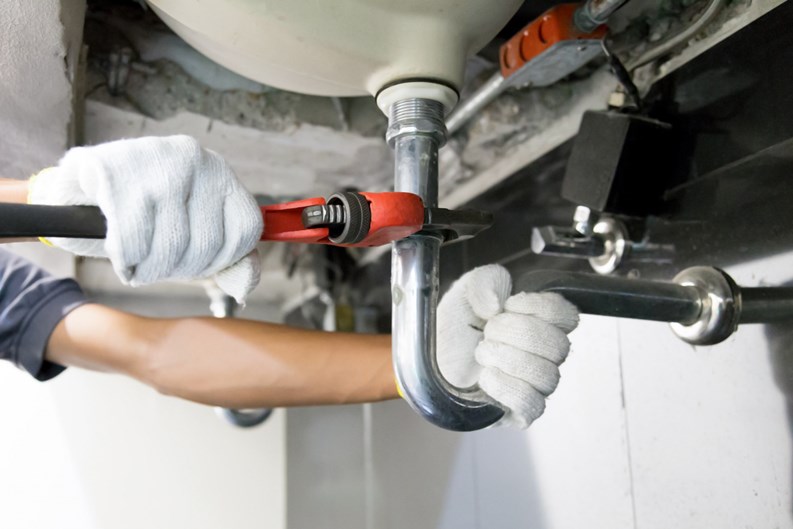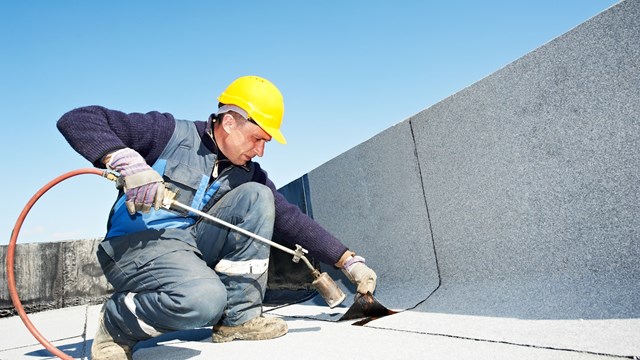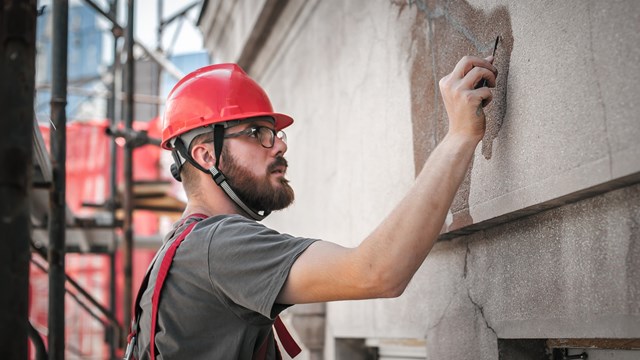Water is a necessity for living—but it’s also a potential hazard for all types of buildings, on both micro and macro levels. Whether it’s the result of extreme weather or an internal plumbing leak, water can cause serious damage to building systems from the exterior masonry and concrete to the interior steel superstructure. The collapse of Champlain Towers South in Florida a few years ago is a glaring example. Left unchecked, even the smallest leak can compromise structural integrity, foster mold growth, trigger insurance battles, and diminish property value. Timely and proper attention paid to water infiltration is key to preserving the integrity of our properties.
All Leaks Great and Small
In general, there are two types of water infiltration: envelope leaks and plumbing leaks. Either type can be minor, or catastrophic. If it’s severe enough (or ignored long enough) a plumbing leak can cause as much damage as an envelope leak.
Sometimes, it’s tough to even tell what type of leak you’re dealing with, warns Fred Webster Jr., Owner of Milltown Plumbing in Chelmsford, Massachusetts. “Folks who live in ground-level garden apartments are most susceptible, not only from trickle-down, but from water infiltration stemming from outdoors,” he says. “And the most common time of year to find a leak is usually the spring, or after a thaw, for a couple of reasons. For starters, people get ice damage, but in ground-level units, if the downspouts aren’t sending water away from the building, either due to snow, [or] if there were extensions that were knocked off during the winter, those folks usually get water infiltration first. We get a lot of calls in the spring from people who think they have plumbing issues, when it’s really just downspout or water runoff issues from heavy rain. Or maybe there’s a failed sump pump in the building that is greatly affecting these folks.”
One property manager who requested anonymity recounted the tale of a burst pipe in an older building their company managed. The leak started on the top floor on the eve of a Labor Day weekend. Over three days, with the building’s managing agent, board, and majority of residents away, the water made its way all the way down to the basement, and caused extensive damage to every unit in the line.
Both plumbing and envelope leaks require immediate attention—no matter how trivial they may seem. “It’s very important to report any leak immediately,” says Giulia Alimonti, an architect and building envelope specialist located in New York City. “Your property manager must monitor and track any moisture infiltration on any exterior surface, because it may lead to damage to the structure of the building. Water corrodes metals, and will corrode your underlying steel structure. In cold climates, when it freezes it expands, and will crack the masonry as well. If the water infiltrates into interior spaces, it may cause the drywall to mold, which can remain hidden for a long time until it becomes so pronounced it can appear as a black stain on the walls.” Mold—particularly the black mold Alimonti references—poses serious health threats to residents and pets, including eye and respiratory irritation, worsening asthma and emphysema, even mood and behavioral disruptions. Mold exposure can be especially harmful to infants and young children, elderly residents, and anyone in the building with an underlying health condition or compromised immune system.
Get Ahead of It
The quickest and most efficient path to preventing leaks and their potential for damage is regular inspections. “The roof, and other exterior envelope components on most structures have warrantees, usually 20 years,” says Ben Messerschmidt, COO of Epic Forensics & Engineering, an engineering firm with offices in West Palm Beach and Orlando, Florida. “Within that period, regular inspections by your roof maintenance contractor are recommended. The standard is twice a year with a corresponding report on conditions. It’s baseline health. The report should also include recommendations for any problems or potential problems in the next year.”
“While there’s not a lot of proactive things that can be done to track potential problems with the exception of casual visual inspections,” says a professional building envelope engineer located in New England, “they should be completed on a regular schedule. Invasive inspections, more in depth and thorough, are generally reserved for some type of observed condition with a suspected underlying problem.”
“The first line of defense is a rigorous inspection program,” says Antonio Argibay, managing principal at Meridian Design Associates, based in New York City. “Exterior inspections are intended to identify deteriorated masonry, compromised flashing, or roof failures before they allow water inside. These inspections should not be viewed as a legal burden but as a critical opportunity to prevent damage that multiplies once water infiltrates a structure. They are mandated to occur every five years in New York City.”
Interior Complications
As mentioned above, one of the most ominous and dangerous complications from water leakage is the development of mold. Mold infiltration can happen in any climate, and while mold growth is often a result of flooding from natural disasters like hurricanes and floods, it can also result from untended or unknown interior leaks unconnected to heavy rain or building envelope leakage.
“Inside the building, leaks from poorly sealed bathrooms, aging plumbing, or faulty dishwasher and washing machine hoses are equally dangerous,” says Argibay. “A slow, hidden leak can saturate finishes and insulation, creating the perfect environment for mold, which can trigger respiratory issues and other health risks. Mold remediation is costly and disruptive, and it almost always starts with water infiltration that went unnoticed or ignored.”
That’s why it’s so crucial to report any signs or symptoms of a leak to management or building staff the moment it’s noticed, or even suspected. “It’s important to be a good neighbor,” says Webster. “If you have somebody living above you, and there’s water on the ceiling above your toilet, it’s likely that they have a toilet in the same exact location upstairs, and it may be leaking. Being an upstanding member of your community in that instance is paramount, because what happens in your unit can affect a lot of other people.”
Cracks or flaking in the ceilings of bathroom and kitchen spaces are typically the result of old paint or dry heat; water infiltration tends to show up more as caking or crumbling plaster, wet areas in drywall, or worst of all, as mold. Damaged areas around windows and door lintels are common sites for leakage that spreads into walls—and even the ceiling, if severe enough. No matter where it appears, residents should report any drips, stains, damp spots, or mold growth to building management immediately.
Webster goes on to stress that residents, managers, and building staff should put a call in to their plumbing pro “within minutes” of discovering a leak, unless they’re absolutely certain they know the origin of it and it’s a very easy fix. “If it’s a water line leak, it could get worse,” he says, “and it’s hard enough to trace hidden leaks in buildings with the leak-detection equipment that we have, like infrared cameras. If it’s complicated to find them when you have the proper training and the tools, imagine what that means for the untrained person. Water can show up far from its origin, so if you don’t see something leaking upstairs, someone without training can lead themselves on a wild goose chase, traipsing around multiple units before identifying an origin.”
An Ounce of Prevention…
The key to preventing leakage and infiltration problems is diligence. As one pro puts it, “Inspect, inspect, inspect!!
“It’s like brushing your teeth,” says Messerschmidt of preventive measures. “If you diligently maintain your building, that maintenance very substantially minimizes the time, expense and repair that will be needed in the event of a problem. Your maintenance program should look like a manufacturer’s suggested program to keep their product in top condition. For instance, a roof contractor will have a recommended maintenance program. Management companies generally include these suggestions in their procedures, and you as the property owners should follow these recommendations. Each component part—roof, masonry, etc.—will have a different cycle. Everything can’t be done by your staff; use your suppliers and warrantees. There’s also a vendor network to support these complicated structures.”
Insurance
As with everything related to property, especially these days, the question arises as to whether insurance will pay for needed repairs and preventative measures. “It depends on the building’s insurance,” says Alimonti. “It also depends on how the damage happened. Was it a result of a repair program that caused new leaks, or was it a maintenance problem? Insurance may cover only part of it.”
“Insurance does cover some of these things,” adds Messerschmidt. “It boils down to nuts and bolts. Most associations’ policies will cover [damage] up to the inside face of drywall. Beyond that, it’s the owner’s policy. Also, coverage may fall back on costs, and whether [a leak] was properly addressed. Insurers are asking for very specific language as to the structural safety of properties these days. ‘Structural safety for intended use’ or ‘free of defects,’ which is way more broad, determines insurability.”
Argibay notes that insurance carriers “increasingly scrutinize water damage claims. Repeated leak-related claims can cause premiums to skyrocket—or policies to be canceled altogether. In condos and co-ops, disputes often arise between boards, managing agents, and individual owners over who is responsible for repairing damage from a leak. Failure to address chronic water infiltration not only leads to higher deductibles and reduced coverage, but also exposes boards to liability claims from shareholders or unit owners who suffer repeated damage. In many cases, insurers will classify water damage as a preventable loss, making it difficult to recover costs if inspections and maintenance are proven to be neglected.”
To Manage or Not to Manage?
Another factor in assessing and addressing leakage and infiltration problems is whether a property is professionally managed or self-managed. “The logistics of accessing units in a self-managed association can be complicated as there isn’t a manager pacing the property regularly,” says our New England based engineering professional, who notes that many condominium associations in New England are on the smaller side and tend to choose self-management. “Deferring that aspect to property managers or vendors is generally preferred. Otherwise the board of directors will usually have to take on that role.” Professional level expertise should be considered critical here.
No matter where you live, water infiltration is one of the most preventable causes of building damage. With regular, thorough inspections, a proactive maintenance program, and a culture of early reporting, boards and managers can protect their residents’ health, preserve property values, and avoid unnecessary insurance disputes. In the long run, prevention is always less expensive—and less disruptive—than remediation.
A.J. Sidransky is a staff writer/reporter for New England Condominium, and a published novelist. He may be reached at alan@yrinc.com.







Leave a Comment